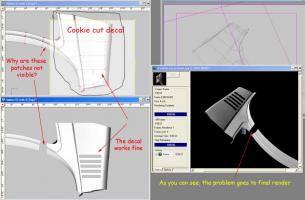
J.Bruce
*A:M User*-
Posts
39 -
Joined
-
Last visited
Profile Information
-
Name
Joshua Bruce
Previous Fields
-
Hardware Platform
Windows
J.Bruce's Achievements

New User (2/10)
0
Reputation
-
J.Bruce started following I want you guys to meet Zero , New model help , Partial enforcement of some constraints and 1 other
-
Is this an orthoscopic view? The hands seem stubby (typically - using Generic Man) the hand is one head in length (base of chin to end of forehead - try it - it's fun). From base of knee to bottom of hip is two heads. Chin to crotch = three (which you have). Width = two. I think the reason he looks thick is because there is no ribcage. The beginning taper is nice for a lean muscular person (Bruce Lee), however, the taper does not continue through to the hips. This taper is typically there due to the fact that the upper-torso is given its volume by the ribcage, while the midsection is given its volume by muscle tension and internal organs (which combined take up less space than the lungs). http://www.hash.com/forums/index.php?showt...free+super+hero J
-
http://www.cgchannel.com/search/search.jsp...t.x=11&post.y=1 I think your facial proportions are off. If you take a measurement from the base of the chin to the bridge of the nose - then take this measurement and place the bottom of the nose the top part will usually be where the forehead muscles end and the hairline begins. Also, the head is usually 5 eyes wide. The base of the nose is usually one eye. The transitional muscle (can't remember what it's called) from the deltoid to the neck begins where the deltoid ends and is usually from collarbone to the line where the base of the chin is. Right now that muscle goes too high (for the average human) which could be why the neck seems short. Right now his neck looks like that of a body builder, however, his deltoids don't seem large enough to justify the size of the trapazoid (I believe that's what it's called). Hope that helps. J
-
To my knowledge you cannot import curves from Illustrator (I know some other apps you can but I've also never tried), however, having said that, you can import an image of the logo. Further, dealing with spline is quite literally the same concept as illustrator curves. Also, because the models can be set to adaptive levels of polygons they have the same benefit of being able to enlarge the space taken up by the model without any loss (whereas straight poly modelers are like dealing with raster images). You have a point and you can change the curvature in and out of the point. This can be done either on both sides of the point at once (setting the cp to smooth), or you can control the curvature on one side of the point (setting the cp to peak). Thereby, rebuilding the logo itself. Now the tutorials that are out are pretty old in relative comparison to the changes made to A:M (I'm sorry), the principles are still good but in some cases there are now better/easier solutions now. Further, there is a utility inside A:M called font wizard: http://www.franksilas.com/glasses.htm http://www.hash.com/sherwood/main/links.asp?id=14 From the guy that made it: http://home.comcast.net/~trickey/index_files/fontwizalg.htm And a whole thread of helpful stuff (including a link to a font wizard thread): http://www.hash.com/forums/index.php?showtopic=6044 Just buy it. You won't regret it. EDIT: I'm a dork. http://home.comcast.net/~trickey/index_files/graphics.htm And the tutorial, http://www.am-guide.com/TinCan/FW-tut.htm
-
Is that directional as well? I ask because with the shadows the way they are it looks like more than just up and down (in and out).
-
Also doublecheck that the nucleus object itself isn't transparent. Because if it is when it's animated it might disappear/reappear earlier or later than expected. Just a thought. It's happened to me before where I forgot about and objects property so it wasn't acting the way I thought it should when I animated it. J
-
I think it's also referred to as breaking the fourth dimension or something weird like that. If you have the focus null I wouldn't even worry about constraints I'd just put it there. Because when you constrain it to something you have less ease of control. Like subtle movement and whatnot. But, yeah just like rob said without seeing a render or a project file it's difficult to truly tell what's going on. J
-
I'm not sure if I understand exactly what's happening. Is like in Ferris Bueler's Day Off when he would look at someone then look at the camera? If so there are a couple of solutions I can think of off the top of my head: 1. Add constraint to character (the one being talked to) [character]. Add another (completely new) constraint to the camera [camera]. Start with the [character] at 100% and [camera] at 0% then go to where you want the character to look at the camera and set [camera] at 100% and [character] at 0%. Change interpolation method to something other than hold. What should happen now is that the enforcement of the [character] constraint will degrade as the [camera] constraints becomes greater. Further, it will happen in such a way that [character] will be at 90% when [camera] is at 10%. This should stabilize any funkyness. 2. Build an eye rig. Then move the "focus" null. That should work. If not let me know. J
-
When you render what are your settings? Try rendering the following (a small render this is just a test): Quicktime Sorenson3 30fps high Then play in quicktime. J
-
Could you render a Wireframe. It's possible the mesh is dense. Which isn't necessarily a bad thing - but if your CPs aren't in the "sweet" spot they will cause undesired dimpling. If you are wanting to add wrinkles what I would recommend is the model her without the wrinkles then apply them using either a bump, or displacement map. J
-
Could you post a couple of example renders and the project file? A:M is a versatile beast and because of that not only are there a dozen possible reasons something went wrong there are the same amount of ways to solve any issue/effect. Thanks J
-
It could be that the cookie cut is applied to a patch but not completely thus no material...no material...no render. Therefore, try this, select just those patches that are effected by the decal (circled in black). Hit the little eye to hide that rest. Apply the decal. Render. Make sure you are starting with a "fresh" model that renders properly otherwise the experiment is pointless. [attachmentid=13110] J
-
http://www.hash.com/forums/index.php?showtopic=13456&hl= That might help. If the wall that your door is cut out of is only one plane / patch then the volumetrics won't read it as a solid object (to my understanding). Therefore, if you make the wall an actual wall it should react to the lights a little better. Hope that helps. J
-
You guys can just call me Josh if you don't mind And, thanks. I'm still not quite sure about the colors so most of the models aren't textured. (except the flower.) And, of course every actor needs a set. So, here you guys go. question I've been out of the loop (and I think I still am) for a while. Have we got a good solution for water? I ask because I have an idea but, I would rather see if it's already been solved before I start driving myself mad trying to figure it out. Thanks. [attachmentid=13010]
-
Those are some pretty creepy looking things. Hopefully Zero won't be that creepy. Thanks for the comment on the tribal feel. I think when I get done it will have an art deco (??) feel. Maybe. Or I could be getting movements confused. Either way I still that Brancusi was a major influence given at the time I was writing a paper on him. I don't want to give too much of the story away but it's basically going to be a simple scene and pretty straight animation. Here is a flower that I did for it. Next should be the set. [attachmentid=12993]
-
Sorry I fell off the planet and wanted to let you know that I'm really impressed with how the image has come along. I know it's probably WAY after the fact but, hey sometimes.










